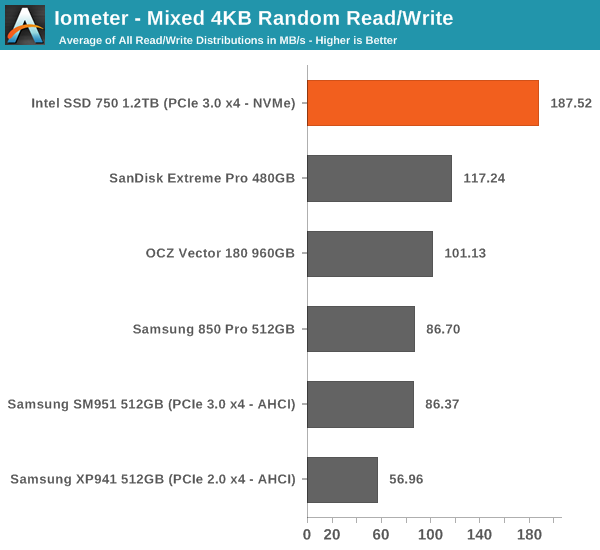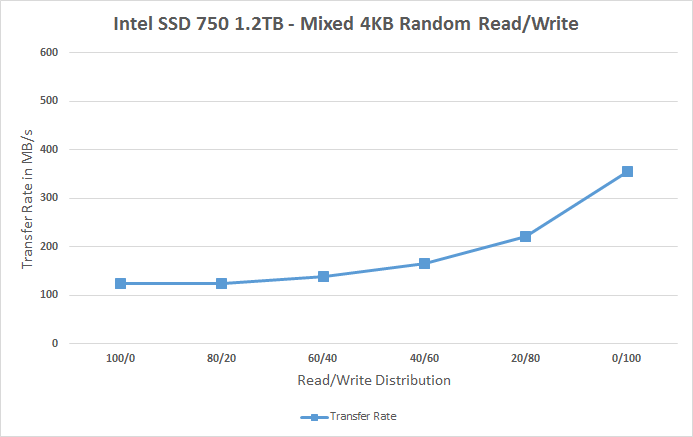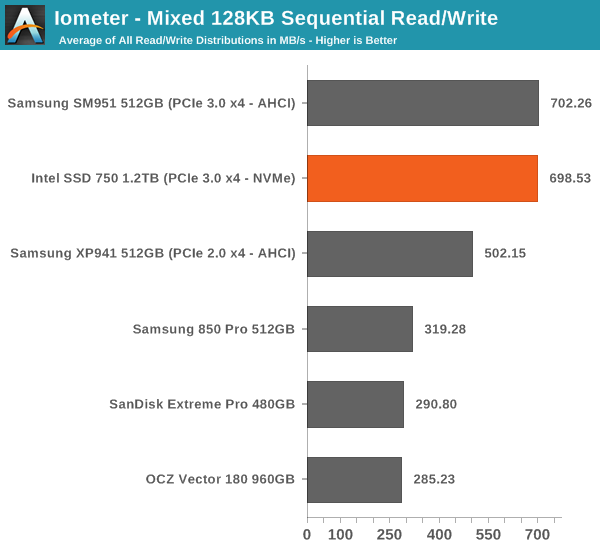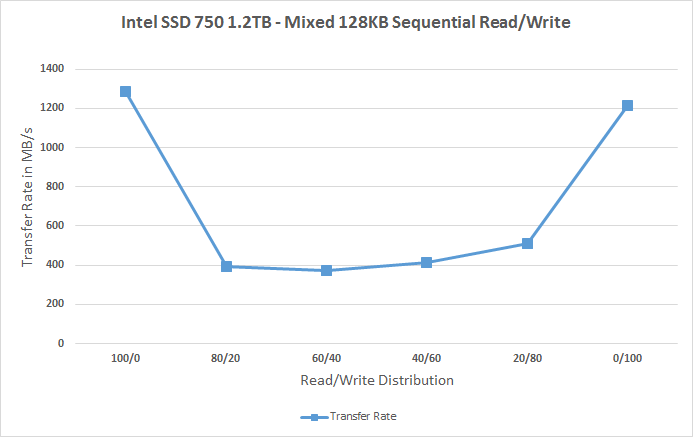Intel SSD 750 PCIe SSD Review: NVMe for the Client
by Kristian Vättö on April 2, 2015 12:00 PM ESTMixed Random Read/Write Performance
Mixed read/write tests are also a new addition to our test suite. In real world applications a significant portion of workloads are mixed, meaning that there are both read and write IOs. Our Storage Bench benchmarks already illustrate mixed workloads by being based on actual real world IO traces, but until now we haven't had a proper synthetic way to measure mixed performance.
The benchmark is divided into two tests. The first one tests mixed performance with 4KB random IOs at six different read/write distributions starting at 100% reads and adding 20% of writes in each phase. Because we are dealing with a mixed workload that contains reads, the drive is first filled with 128KB sequential data to ensure valid results. Similarly, because the IO pattern is random, I've limited the LBA span to 16GB to ensure that the results aren't affected by IO consistency. The queue depth of the 4KB random test is three.
Again, for the sake of readability, I provide both an average based bar graph as well as a line graph with the full data on it. The bar graph represents an average of all six read/write distribution data rates for quick comparison, whereas the line graph includes a separate data point for each tested distribution.

The SSD 750 does very well in mixed random workloads, especially when compared to the SM951 that is slower than most high-end SATA drives. The performance scales quite nicely as the portion of writes is increased.
 |
|||||||||
Mixed Sequential Read/Write Performance
The sequential mixed workload tests are also tested with a full drive, but I've not limited the LBA range as that's not needed with sequential data patterns. The queue depth for the tests is one.

In mixed sequential workloads, however, the SSD 750 and SM951 are practically indentical. Both deliver excellent performance at 100% reads and writes, but the performance does drop significantly once reads and writes are mixed. Even with the drop, the two push out 400MB/s whereas most SATA drives manage ~200MB/s, so PCIe certainly has a big advantage here.
 |
|||||||||










132 Comments
View All Comments
mmrezaie - Thursday, April 2, 2015 - link
finally it has started, although I wont budge now. maybe next generation.blanarahul - Thursday, April 2, 2015 - link
Hey Kristian, I read that the 1.2 TB model uses 84 dies. But that's not a multiple of 18. So what gives? Is it running in 14 channel mode or something?blanarahul - Thursday, April 2, 2015 - link
Okay so it has 86 dies. But now it's even more confusing. Aren't they supposed be multiples of number of channels the controller is using?SunLord - Thursday, April 2, 2015 - link
Its likely 18 channels so 4 probably only address 4 dies while the 14 other channels handle 5woggs - Thursday, April 2, 2015 - link
yepTyrDonar - Friday, April 10, 2015 - link
Controllers don't have to operate on a specific multiple of the number of dies. That's just a coincidence as to how we've seen them so far on most SSD's. They can operate with varying priorities and asymmetrically. Further, more than 1 channel can address the same die in different intervals/priorities. As controllers become more and more complex, this kind of assymetrical operation will become more common, unfortunately this is correlated with increasing number of total dies and lower reliability.huaxshin - Thursday, April 2, 2015 - link
Will there be any M2 SSDs from Intel with NVMe? Some notebooks, and desktops, have routed PCIe to M2 slots where its the only place its available.blanarahul - Thursday, April 2, 2015 - link
No.DigitalFreak - Thursday, April 2, 2015 - link
Not with this controller. Maybe down the road.bgelfand - Thursday, April 2, 2015 - link
I suspect this drive is not for the current z97 chip set, but will realize its potential with the Z170 chipset (Sunrise Point) due for release in the second half of this year with Skylake. The Z170 chipset has 20 PCIe 3.0 lanes and DMI 3.0 (8 GB/s) bus interface.It should be a very interesting second half of the year - Skylake CPU, Sunrise Point chipsets, and Windows 10.